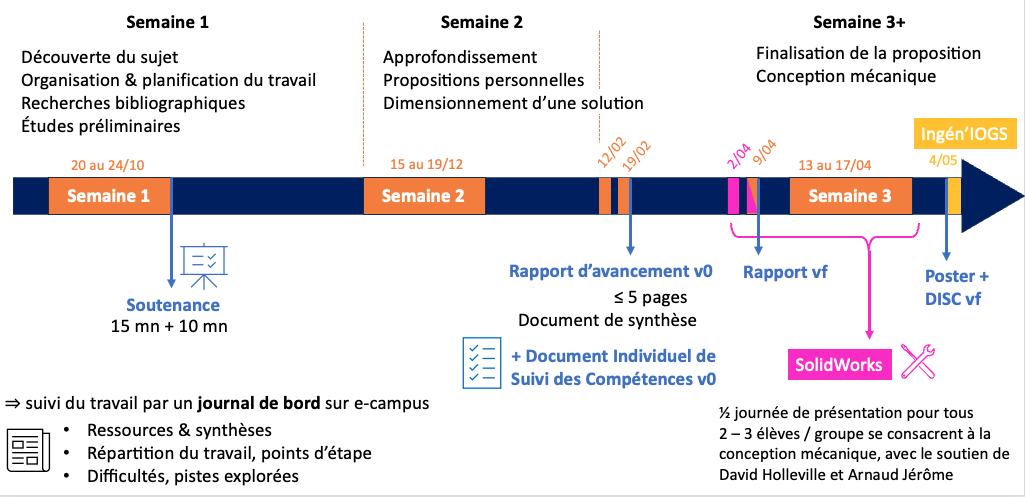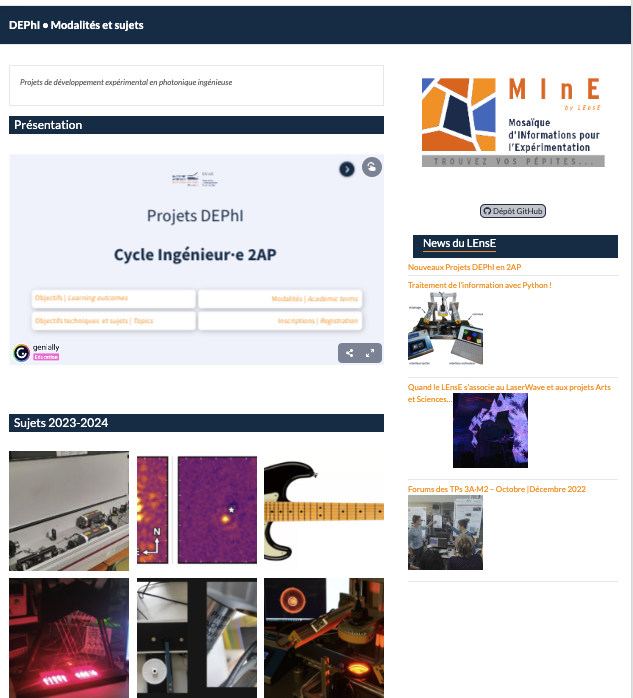Projets MOSAIC - DEPhI
Topic outline
-
♦ Projets Mosaic : Modélisation Optimisation Simulation Analyse Ingénierie Conception ♦
Concevoir et/ou modéliser un système optique complet en combinant différentes disciplines : optique instrumentale, photométrique, mécanique, optique physique, traitement des images, couches minces optiques
Encadrements des équipes : Gaëlle Lucas-Leclin, Julien Moreau, Franck Delmotte et Irène PapagiannouliFormation et suivi SolidWorks : David Holleville et Arnaud Jérome
--> + d'infos sur les sujets dans la présentation ci-dessous et les menus ci-contre.
Modalités d'évaluation
- Une soutenance de 15 min + 10 mn de questions en fin de première semaine ou vous présenterez votre bibliographie, les éventuelles premières simulations numériques et une liste des tâches pour la suite.
- Remise d’un rapport et des documents collaboratifs de suivi du projet après la 2ème semaine
- Remise d'un document individuel de suivi des compétences mises en œuvre dans le cadre du projet
- Présentation d’un poster lors d’IngénIOGS en fin d’année + documents collaboratifs de suivi du projet
-------------------------
♦ Projets DEPhI : Développement Expérimental en Photonique Ingénieuse ♦
Concevoir, réaliser, tester et documenter un dispositif scientifique complet.
Encadrements des équipes : Fabienne Bernard, Jeanne Bernard, Arnaud Dubois, Sylvie Lebrun, Rosa Tualle-Brouri, Benjamin Vest, Lionel Jacubowiez, Julien Villemejane, Thierry Avignon, Cédric Lejeune.
+ d'infos
-------------------------
♦ Planning ♦
Les projets MOSAIC et DEPhI se clôturent par le forum IngénIOGS prévu le 04 mai 2026.
-
Vous trouverez dans cette section les informations générales relatives aux projets MOSAIC et les documents partagés.

-
Le DISC (Document Indidivudel de Suivi des Compétences) est un document qui décrit comment, dans le cadre du projet MOSAIC, chacun de vous revendique pouvoir valider deux compétences du référentiel ingénieur SupOp' :
- C2 : concevoir et dimensionner
- C7 : travailler en équipe
Pour chacune de ces compétences, un ensemble de critères d'exigence spécifie les attentes, avec plusieurs niveaux d'exigence. Dans le cadre du projet MOSAIC, les attentes pour ces compétences sont :
→ C2 : 2 critères de niveau ≥3 , aucun à 0
→ C7 : 3 critères de niveau ≥2Chacun de vous doit préparer une synthèse des compétences acquises en s'appuyant sur un port-folio (format libre) permettant de documenter et prouver le niveau de compétences atteint. Une première version du DISC, correspondant à l'état actuel de vos compétences acquises, est demandé pour le 19/02/2026. La version finale sur laquelle s'appuiera la validation, après retour de l'équipe pédagogique, est exigée pour le 4/05/2025.
Vous trouverez ci-dessous différents documents et liens qui vous ont été présentés au sujet de ce DISC.
-
Présentation interactive des 9 compétences de l'ingénieur·e IOGS
-
Éléments d'information sur le Document Individuel de Suivi des Compétences (site du LEnsE) : compétences et critères d'exigence
-
Détail des critères d'exigence par compétences, avec les différents niveaux d'expertise associés
-
-
L'initiative mesoSPIM est un projet international collaboratif open-source pour la conception et l'utilisation d'un microscope bas-coût adapté à l'observation d'échantillons de dimension centimétrique (échelle 'méso') avec une résolution micrométrique en 3D. Le dispositif utilise une nappe de lumière qui se déplace, suivant la technique dite SPIM pour 'Selective Plane-Illumination Microscopy'.
Nous proposons de partir plus spécifiquement du travail décrit dans l'article 'Benchtop mesoSPIM: a next-generation open-source light-sheet microscope for cleared samples', Nature Communications 15, 2679 (2024), pour en comprendre les principes, les choix techniques, et étudier la possibilité de solutions alternatives.
-
-
Bibliographie sur le sujet
-
Liens vers les données de l'article
-
Benchtop mesoSPIM: a next-generation open-source light-sheet microscope for cleared samples
articles et documentations
-
In the three connected papers, a systematic analysis and synthesis approach for microscope objectives is introduced. To subtract off the hidden assumptions in the historical development of the microscope objective lenses and extract the intrinsic lens modules, a large objective database is implemented including most of the patented systems for standardised applications. Based on the systematic analysis of the database, in Part I, a general review of the development history is given. A systematic classification method is proposed with respect to the five most significant parameters. According to the review and classification, the impacts of applications, manufacture and technology considerations are systematically analysed and summarised.
Details of the lens modules will be discussed in Part II, and the synthesis approach utilising the lens modules will be introduced in Part III.
links
- https://www.degruyterbrill.com/document/doi/10.1515/aot-2019-0002/html
- https://www.degruyterbrill.com/document/doi/10.1515/aot-2019-0013/html
- https://www.degruyterbrill.com/document/doi/10.1515/aot-2019-0014/html
PDF files in the folder
- https://www.degruyterbrill.com/document/doi/10.1515/aot-2019-0002/html
-
Des premières pistes pour l'évaluation des performances radiométriques de MesoSPIM
-
LensNet : Lens design starting point generator
https://opg.optica.org/oe/fulltext.cfm?uri=oe-27-20-28279
-
-
CONTEXTE ET OBJECTIFS
Dans ce projet on s’intéresse au Soleil et l’émission des raies spectrales atomique dans la domaine de l’extrême ultra-violet (EUV) par sa couronne. Depuis plusieurs dizaines d’année il y a eu de nombreuses missions spatiales lancées afin de caractériser l’activité solaire. Le développement récent des microsatellites permet de réduire considérablement les coûts mais également l’impact énergétique de telles missions. Cependant, le faible volume disponible impose des contraintes fortes sur la conception des instruments, et en particulier sur le design optique. Au cours de ce projet vous allez concevoir et optimiser un imageur et un spectromètre destinés à être intégrés dans un microsatellite. Vous vous intéresserez aux performances optiques, mais également à la consommation électrique, au budget de poids et de volume disponible dans un microsatellite, à la conception mécanique et au coût global de l’instrument.
Références:
1. «Future Prospects for Solar EUV and Soft X-Ray Spectroscopy Missions», Front. Astron. Space Sci., 8, 2021, https://doi.org/10.3389/fspas.2021.662790. (article disponible ci-dessous)
2. «SunCET: The Sun Coronal Ejection Tracker Concept», J. Space Weather Space Clim., 11, 2021, https://doi.org/10.1051/swsc/2021004. (article disponible ci-dessous)
Organisation:
Le travail sera mené en équipes. Vous veillerez à vous répartir les tâches, à maintenir à jour un cahier de manip partagé en ligne (Wiki) pour le suivi de l’avancement du travail, à organiser entre vous des temps d’échanges et de discussions pour que tous les aspects du projet soient menés en harmonie.Objectifs:
Semaine 1:
· Prise en main du sujet et recherche bibliographique : imagerie de la couronne solaire en EUV, technologies CubeSats et compréhension du contexte.
· Réflexion sur le cahier des charges et la résolution souhaitée.
· Étude préliminaire : définition des éléments principaux d’un microsatellite (par exemple, détecteurs, filtres, etc.) et élaboration d’un schéma bloc.
· Propositions des systèmes optiques à étudier pour la deuxième semaine.
· Répartition des tâches entre les membres du groupe.
· Découverte d’un logiciel de conception de couches minces - IMD.
· Première conception des couches minces et des filtres.
· Identification d’autres aspects à explorer : type de détecteur, consommation électrique, poids, volume, coût, bilan photométrique.
· Élaboration du planning pour la 2e semaine (décembre).
· Préparation d’une présentation de 15 minutes.
· Soutenance (vendredi).
-
Quelques ressources complémentaires:
- Handbook of Optical Systems, H. Gross (Wiley-VCH, 2006), §43 consultation à la médiathèque ou extrait disponible ci-dessous
- Site web du CXRO : calcul transmission et réflectivité des optiques EUV en ligne : https://henke.lbl.gov/optical_constants/
- Simulations Zemax: How to build a spectrometer: https://support.zemax.com/hc/en-us/articles/1500005578762-How-to-build-a-spectrometer-theory
- Handbook of Optical Systems, H. Gross (Wiley-VCH, 2006), §43 consultation à la médiathèque ou extrait disponible ci-dessous
-
-
-

